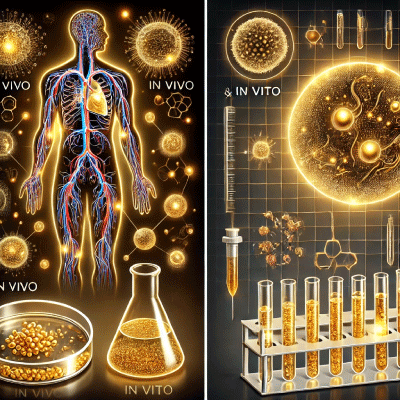Comparing in vitro and in vivo Ligands
Gold nanoparticles (AuNPs) functionalized with ligands are widely used in both in vitro (lab-based) and in vivo (within living organisms) applications. The choice of ligands and their properties can significantly influence the performance and suitability of AuNPs for specific applications. Here is a comparison of in vitro and in vivo ligands for AuNPs, focusing on their design, functionality, and application.
In Vitro Ligands for Gold Nanoparticles
Requirements and Characteristics:
- Versatility: In vitro ligands need to be versatile to suit a variety of experimental conditions and purposes, including biochemical assays, cell culture studies, and material science experiments.
- Ease of Synthesis: Ligands used in vitro often require simpler and more cost-effective synthesis methods, allowing for rapid functionalization and high-throughput screening.
- Stability: Stability is important but can be more easily managed in controlled laboratory settings compared to the complex environments found in vivo. This allows for a broader range of chemical compositions and surface modifications.

Conceptual comparison between in vivo and in vitro applications of gold nanoparticles.
Applications:
- Biosensing: Ligands functionalized on AuNPs can bind to specific analytes (e.g., proteins, DNA, toxins), causing detectable changes in the optical properties of the nanoparticles, making them useful in biosensors for diagnostic tests and environmental monitoring.
- Catalysis: AuNPs with ligands that provide specific reactive sites or stabilize catalytic intermediates can enhance catalytic processes in vitro, improving reaction rates and selectivity.
- Cell Studies: Ligands can facilitate the study of cellular processes by enabling AuNPs to interact with cell surface receptors, track cellular uptake, or deliver specific molecules to cells in culture, providing insights into cellular mechanisms and drug efficacy.
In Vivo Ligands for Gold Nanoparticles
Requirements and Characteristics:
- Biocompatibility: Ligands must be non-toxic and biocompatible to avoid adverse immune reactions and other side effects within living organisms. Common biocompatible materials include polyethylene glycol (PEG) and various biomolecules like peptides and antibodies.
- Stability: In vivo applications require ligands that can provide stability in the complex and dynamic physiological environment, protecting AuNPs from aggregation, enzymatic degradation, and clearance by the immune system.
- Targeting: Specificity is crucial for in vivo applications, particularly for targeted drug delivery and imaging. Ligands such as antibodies, peptides, and small molecules can be used to target specific cells, tissues, or pathogens.
- Stealth Properties: To evade the immune system and prolong circulation time in the bloodstream, ligands often include "stealth" features like PEGylation, which masks the nanoparticles from immune recognition.
Applications:
- Drug Delivery: Functionalized AuNPs can deliver therapeutic agents to specific target sites within the body, enhancing treatment efficacy and minimizing side effects. Targeting ligands ensure that drugs are delivered precisely to the diseased cells or tissues.
- Imaging and Diagnostics: Ligands specific to biomarkers can be used to functionalize AuNPs for enhanced imaging techniques such as MRI, CT, or fluorescence imaging, aiding in the early detection and monitoring of diseases.
- Theranostics: AuNPs with multifunctional ligands can be used for theranostics, which combines therapeutic and diagnostic capabilities, providing real-time feedback on treatment efficacy while delivering therapy.
Comparison of In Vitro and In Vivo Ligands
Biocompatibility and Safety:
- In Vivo: High biocompatibility and safety are essential to prevent adverse immune reactions and ensure long-term stability within the body. Ligands often include biocompatible polymers and targeting moieties.
- In Vitro: While biocompatibility is important, especially in cell culture studies, there is more flexibility in ligand design, and higher toxicity levels may be acceptable for certain non-biological applications.
Functional Specificity:
- In Vivo: Functional specificity is critical for targeting specific tissues or cells, requiring precise ligand-receptor interactions. This specificity can be achieved through antibodies, peptides, or small molecules that recognize specific biomarkers.
- In Vitro: Specificity is also important but can be tailored for a broader range of targets and functions, including binding assays, catalysis, and detection. Versatility and ease of modification are advantageous in a controlled laboratory setting.
Stability and Environmental Conditions:
- In Vivo: Ligands must ensure the stability of AuNPs in complex and dynamic physiological environments. They should resist degradation and maintain functionality under varying pH, ionic strength, and the presence of biological molecules.
- In Vitro: Stability is important but can be more easily controlled. Environmental conditions are typically more stable and can be optimized to suit the experimental needs, reducing the stringent requirements on ligand robustness.
In conclusion, while both in vitro and in vivo ligands for AuNPs share some common requirements, they differ significantly in terms of biocompatibility, stability, and functional specificity due to their distinct application environments. The design and choice of ligands must be tailored to meet the specific demands of their intended use, leveraging the unique properties of AuNPs to achieve desired outcomes.
For further information, go to our home page gold nanoparticles.

